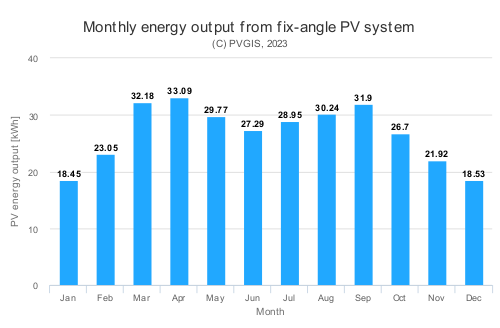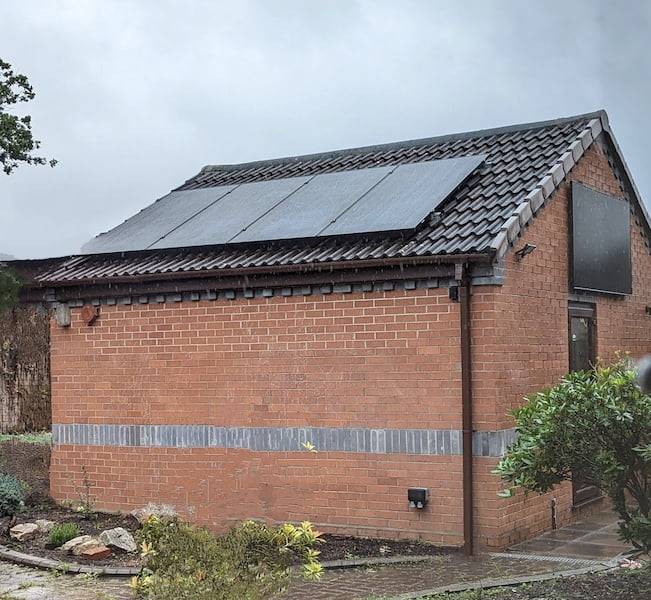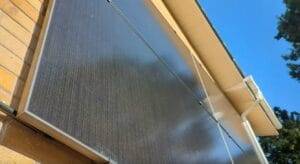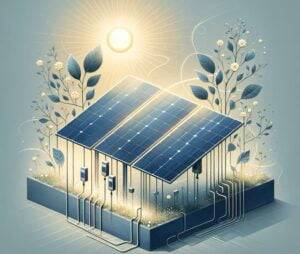Updated for 2025: Comprehensive guide to optimising your solar energy production in the UK. Discover optimal tilt angles, seasonal adjustments, and why “perfect” isn’t always best for your wallet.

The Earth’s axis is tilted, causing variations in the sun’s path across the sky throughout the year. Therefore, a solar panel’s tilt angle governs how much solar energy it captures throughout the year.
Solar Angle And Generation Calculator
This calculator will give you an average yearly yield estimation using the optimal angle for the approximate latitude of your selected location (city, country, state, etc.).
Simple Solar Energy Generation Calculator
What is the Best Position for Solar Panels in the UK?
For optimal energy production in the UK panels need to point South. The next best directions are East and West, with insignificant differences.
In the following table, we see a comparison of how tilt angle and panel orientation affect yearly production. The annual PV production is measured in kWh.
| Estimated yearly generation for a single 430W panel | |||||
|---|---|---|---|---|---|
| Direction | 40° (optimal angle) | 0° flat | 52.5 | 37.5° | 67.5° |
| South | 440.8 kWh | 336 kWh | 427 kWh | 434 kWh | 398 kWh |
| East | 343 kWh | 336 kWh | 322 kWh | 343 kWh | 289 kWh |
| West | 336 kWh | 336 kWh | 313 kWh | 336 kWh | 281 kWh |
| North | 215 kWh | 336 kWh | 173 kWh | 223 kWh | 133 kWh |
According to this calculation, the best position is south-facing at ~40°.
Update for 2025: The East-West Split Strategy
While South is best for total numbers, the rise of home battery storage has made the East-West split array increasingly popular. Instead of a massive spike at noon (which you might not use), you get a wider generation curve: East panels wake up early for breakfast, and West panels catch the late afternoon sun to top up your battery before evening.
I calculated the optimal angle value using this calculator.
Using the calculator mentioned above, you can calculate your system’s estimated annual PV energy production, too. The field for tilt angle is named Slope, and the field for direction is named Azimuth.
Why Flat Solar Panels Mounting is Suboptimal?
The table above indicates that flat panels perform better than some at steeper angles. However, depending on how best to use the produced energy, we may want to optimise for other factors.
When using solar energy to power our homes, we should prefer more consistent output compared to huge production in summer and minimal to no output in winter. Let’s see how the generated energy spreads over the year.
To emphasise the point, let’s look at two sub-optimal positions. We’re comparing a flat panel against a 90° wall-mounted south-facing panel.


From this analysis, we can conclude that if you are installing panels for the purpose of selling electricity at a flat rate, then you are better off going with a flat tilt angle. However, if you are optimising for year-round home consumption, and your choice is between a flat or wall-mounted one, go for the wall-mounted one.
This advice is nuanced. The further from the equator you are, the stronger the advice applies to you. Inversely, the closer you are to the equator, the worse you are for following this advice Theoretically, the best position at the equator is a flat mount.
Solar Panel Tilt Angles for UK Cities
| City | Summer Tilt | Winter Tilt | Optimal Calculated (Year-Round) | |
|---|---|---|---|---|
| Southampton | 35.9° | 65.9° | 40° | |
| London | 36.5° | 66.5° | 40° | |
| Birmingham | 37.5° | 67.5° | 40° | |
| Newcastle | 39.9° | 69.9° | 43° | |
| Edinburgh | 40.9° | 70.9° | 42° | |
| Aberdeen | 42.1° | 72.1° | 43° |
For the optimal value calculation I used the calculator by the European Commission’s Photovoltaic Geographical Information System.
For more details, see Source World estimates of PV optimal tilt angles and ratios of sunlight incident upon tilted and tracked PV panels relative to horizontal panels, Department of Civil and Environmental Engineering, Stanford University, Stanford, CA 94305-4020, USA. The paper offers a comprehensive table of recommended tilt angles for all countries.
What are some Solar Panels Angles for Optimal Performance Worldwide
From our analysis of three comprehensive studies, the following recommendations emerge:
- Latitude-Based Tilt: A general rule of thumb suggests setting the tilt angle approximately equal to the geographical latitude of the location. For example, with a latitude of 51.5°N, London would have an optimal tilt angle of roughly 51.5°.
- Adjustments for Seasons: Some experts recommend adjusting the tilt angle seasonally. In summer, a tilt angle of 15° less than the latitude might be more effective when the sun is higher. In contrast, an angle of 15° more than the latitude in winter can capture more sunlight.
Note: The exact optimal tilt can vary based on local conditions, such as obstructions or specific weather patterns.
Optimal Tilt Angles Based on Latitude with City Examples
| Latitude Range | Major Cities | Optimal Tilt (Year-Round) | Summer Tilt | Winter Tilt |
|---|---|---|---|---|
| 0° – 10° | Bogota, Jakarta | Latitude | Latitude – 15° | Latitude + 15° |
| 10° – 20° | Mumbai, Mexico City | Latitude | Latitude – 15° | Latitude + 15° |
| 20° – 30° | Cairo, New Delhi | Latitude | Latitude – 15° | Latitude + 15° |
| 30° – 40° | Athens, Los Angeles | Latitude | Latitude – 15° | Latitude + 15° |
| 40° – 50° | London, Tokyo | Latitude | Latitude – 15° | Latitude + 15° |
| 50° – 60° | Glasgow, Oslo | Latitude | Latitude – 10° | Latitude + 20° |
| 60° – 70° | Reykjavik, Tromsø | Latitude + 5° | Latitude | Latitude + 25° |
| 70° – 80° | Longyearbyen, Nuuk | Latitude + 10° | Latitude + 5° | Latitude + 30° |
Can You Have Solar Panels at Different (Mixed) Angles?
Yes, you can have solar panels installed at different angles. There are a few strategies to achieve this. Microinverters or solar optimisers are the most effective way to approach this problem.

These high-level components allow each solar panel to operate independently, maximising the energy production of each panel regardless of the angle or orientation.
Another way to solve this problem is to explore different connections. You can choose to wire in parallel or series to counteract the adverse effects of difference in performance due to the sub-optimal angles in part of your string.
It’s important to note that having solar panels at different angles can make your solar energy system more complex to design, install, and maintain. If in doubt, seek advice from a professional solar installer to help with optimising your system for maximum energy production.
Can I install horizontal solar panels?
Horizontal installation of solar panels has its advantages and disadvantages.
Advantages:
- Ease of Installation: Horizontal panels require no special mounts or tilting mechanisms.
- Work Well In Cloudy Weather: In overcast conditions flat panels can produce better results than panels at larger tilt angles.
- Aesthetics: For homeowners concerned about the visual impact, flat panels might blend more seamlessly with the roof.
Disadvantages:
- Reduced Efficiency: Solar panels tilted at 0° might not capture sunlight as effectively as those tilted optimally, especially in higher latitudes.
- Snow Accumulation: Flat panels can accumulate snow in snowy regions, blocking sunlight and reducing energy production.
- No Self-Cleaning: The minimum angle for self-cleaning is 10°.
My Experience With Nearly Flat Panels
In May 2024 I built a solar gazebo to expand my PV capacity. The location where I built the gazebo falls under height regulation from the local Building Regulations authority. Hence, I had little room to work with on the roof angle. My initial plan was to maximise the tilt, however after some aesthetic optimisation I ended up with a 6° agnle.

In the images above, you can see how rainwater cannot fully drain from the panels. This means that part of the dust the rain washed down from the panel remains as residue and builds up under those puddles.
What is the Minimum Angle for Solar Panels?
There is no minimum angle as an absolute value. However, it is recommended that solar panels be installed at a tilt angle of at least 10°. This angle allows rainwater to wash away dust and debris, and it is also referred to as the minimum angle for self-cleaning. As stated in the paper by Stanford University quoted above, even at the equator, where the optimal angle theoretically is 0°, installers tilt panels at 10° to allow rainwater to wash away efficiently.
At What Angle Do Solar Panels Stop Working?
Solar panels don’t exactly “stop working” at any specific angle, but their efficiency can significantly decrease if the angle isn’t optimal. Solar panels work by absorbing sunlight and converting it into electricity.
The more direct sunlight the solar panels receive, the more electricity they can generate.
If the angle is too steep or flat relative to the sun’s position, the sunlight will hit the panels at an oblique angle, reducing the energy they can produce. For instance, a solar panel that’s lying flat (0-degree tilt) will produce less electricity in the winter months when the sun is low in the sky. Conversely, a solar panel standing upright (90-degree tilt) will produce less electricity in the summer when the sun is high in the sky.
However, the angle can’t be so steep or flat that the solar panels stop working. Even at less-than-optimal angles, solar panels will still produce electricity as long as they receive sunlight.
In conclusion, while the angle can significantly impact the efficiency of solar panels, it won’t cause them to stop working. With the right planning and design, you can optimise your solar energy system to produce a significant amount of electricity throughout the year, regardless of the angle of your solar panels.
Installing Solar Panels On A Flat Roof
The straightforward approach is to install your panels flat along the roof. However, as discussed above, flat mounts have disadvantages.
Solar panels on flat roofs or the ground are installed at an angle to mitigate the adverse effects of horizontal mounting. Angling is achieved using frames holding the panels at the desired tilt. These frames are typically held down by ballast weight from concrete blocks and some mounting equipment vendors offer flat roof mounting trays that can be filled with sand for ballast.
Expert Tip: Bifacial Panels and Tilt
If you are ground-mounting or using a flat-roof frame, consider bifacial panels. These collect light from both sides—direct sunlight on the front and reflected light (albedo) on the back. For bifacial panels, a steeper tilt (e.g., 45° or even vertical) can be incredibly powerful if you have a reflective surface underneath (like white gravel or concrete). This setup can boost total generation by 5-20% compared to standard monofacial panels.
Illustrative Ballasting Requirements for Flat Roof Solar Panels in England
| Region | Average Annual Wind Speed (m/s) | Recommended Ballast Weight (kg) | Note |
|---|---|---|---|
| Southeast (e.g., London) | 4 – 6 | 40 – 50 | Urban areas require less ballast due to windbreaks. |
| Southwest (e.g., Bristol) | 5 – 7 | 50 – 60 | Coastal areas require more ballast due to higher wind speeds. |
| Midlands (e.g., Birmingham) | 4 – 6 | 40 – 50 | Urban areas require less ballast. |
| Northwest (e.g., Manchester) | 5 – 8 | 50 – 65 | Coastal and hilly regions need more ballast. |
| Northeast (e.g., Newcastle) | 5 – 8 | 50 – 65 | Coastal and hilly regions need more ballast. |
| Yorkshire (e.g., Leeds) | 4 – 7 | 45 – 60 | Varied requirements based on local geography. |
Please note the above values are illustrative. The weight requirements depend on how high the roof is and what conditions are expected in your environment. For example, areas with typical strong winds, like coastal areas, will require extra weight to be added.
It’s important to understand that while calculations can provide a baseline or starting point, actual recommendations often come from a combination of calculations, real-world testing, industry standards, and practical experience. Ballast weights also need to counteract maximum wind speed. The maximum wind speed in London is around 30 m/s.
- Safety Margins: It’s common practice to apply a safety margin when determining ballast requirements. For instance, if calculations suggest a weight of 5 kg is required, a safety factor of 3 might be applied, leading to a recommendation of 15 kg.
- Wind Gusts & Turbulence: Average wind speeds don’t account for gusts, which can exert significantly higher forces. Turbulence, especially in urban areas, can also increase the effective wind speed at the panel’s location.
- Other Forces: The potential for wind to get underneath a panel and lift it can significantly increase the required ballast weight. This is especially true if the panel is not entirely flush with its mounting surface.
- Conservatism: In engineering, especially where safety and property damage are concerns, it’s common to err on caution.
Consider the height of the roof where panels are installed too. Wind speed increases with the increase in height. This is due to the frictional effects of the ground or obstacles on the wind, which slow it down at lower levels. Here is an illustrative increase of wind speed at typical residential floor heights.
- Ground 0m: 0m/s (This is the base value; in practice, there will be a non-zero wind speed at ground level, but for our calculations, we used this as the reference point)
- First Floor 3m: 6.95m/s
- Second Floor 6m: 8.56m/s
- Third Floor 9m: 9.67m/s
Conclusion
The tilt angle of the solar panels plays a significant role in your system’s optimal energy production. Solar panel installation in the UK will benefit from angles tilted at 40° more than it would from flat panels. The optimal angle depends on the latitude, and additional seasonal adjustments can be beneficial.
Did you like this article? Would you like to share your feedback? Then head over to Solar Energy Concepts on facebook , where you can talk about this article and tell me what you think.









